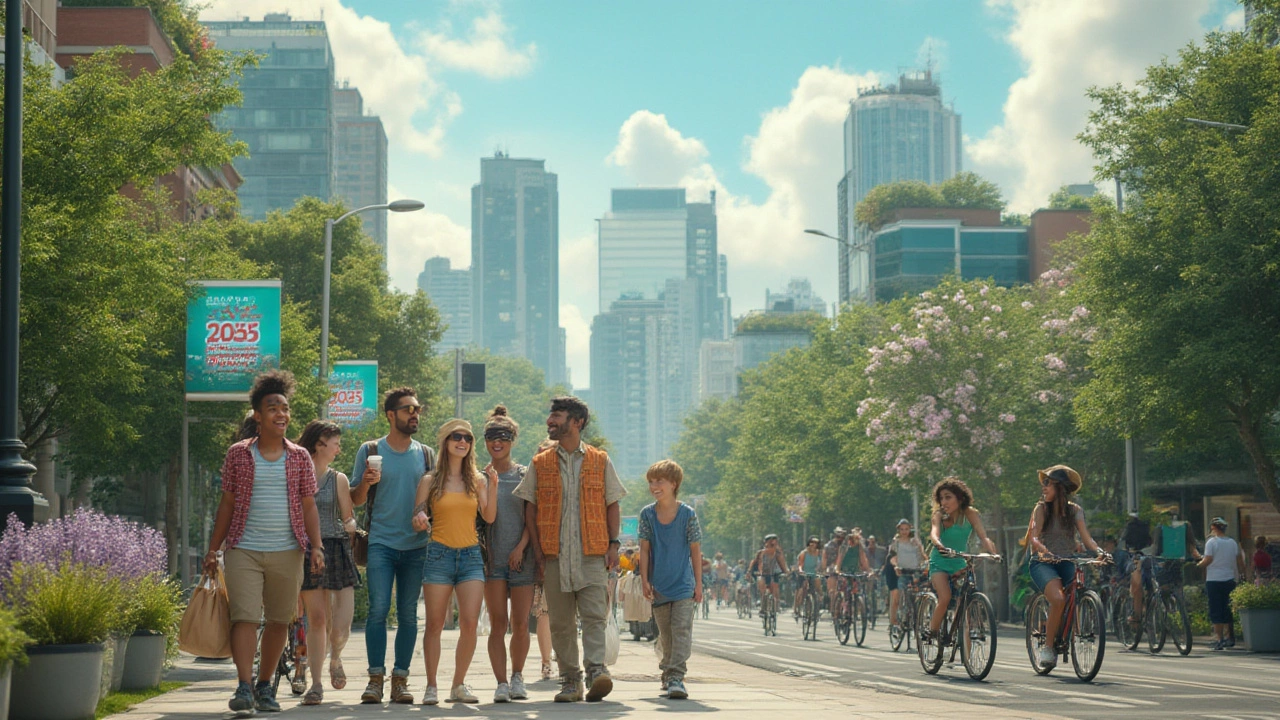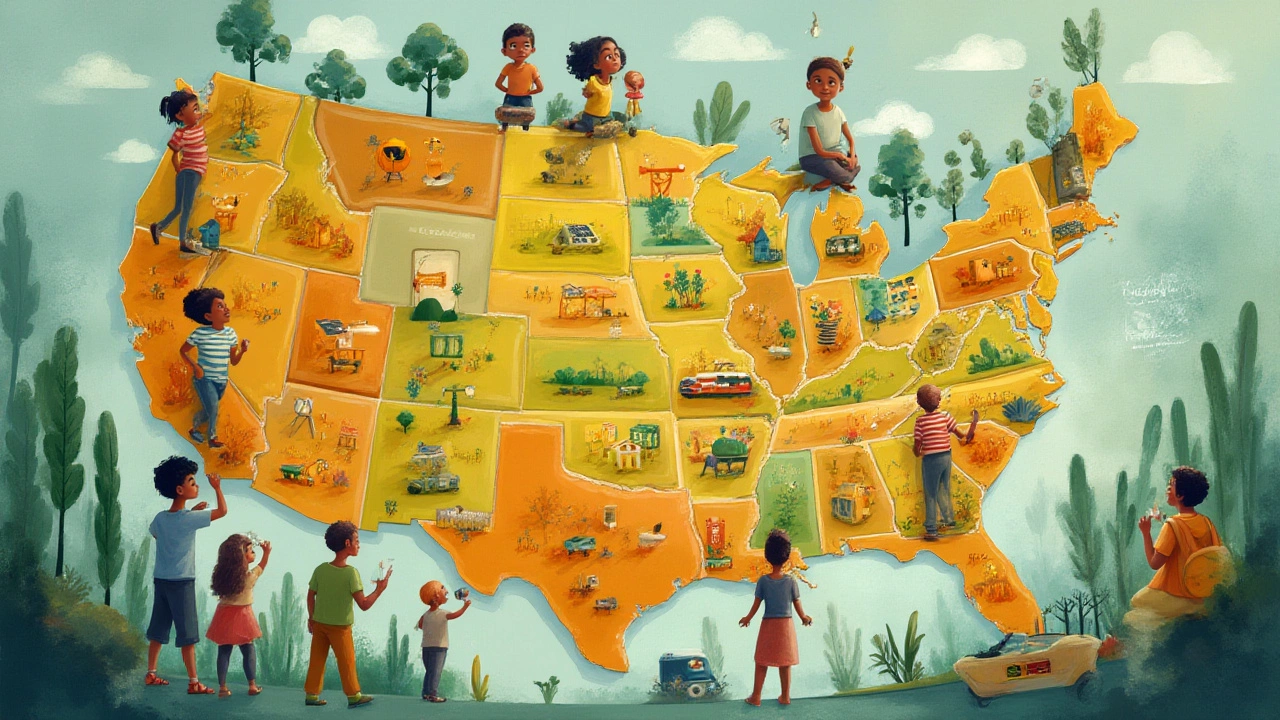Picture this: You’re breathing in crisp mountain air, sipping water straight from a stream, and munching on veggies grown less than five miles away. It sounds almost science-fiction at this point, right? With plastic bags tumbling down highways, cities battling smog, and the constant hum of artificial light drowning out the stars, it feels like true environmental paradise is slipping away in the US. But here’s the jaw-dropper: not only do some states pull ahead in the green race—they set standards you might wish your own hometown would copy. Jasper, my cat, would be rolling in organic catnip if he realized how many of these places have animal-friendly policies too.
The Green Race: How States Stack Up Environmentally
The contest to claim 'the most environmentally friendly state' isn’t just a marketing ploy for eco-tourism. Every year, watchdogs like the Environmental Protection Agency (EPA), WalletHub, and the U.S. Energy Information Administration crunch tons of data to see which states actually walk the walk. They check energy sources, emissions, waste, air and water quality, wildlife protection, and how much locals really recycle (not just say they do in surveys—big difference!).
If you want the cold facts, look at this quick snapshot from 2025’s big environmental rankings. The best states didn’t get their spots by installing a few solar panels or banning plastic straws in one city. To win, they went all-in—slashing energy waste, saving water, and protecting green spaces so fiercely that other states started seeing copycat policies pop up. The top states for green living this year probably won’t shock you—most are known for clean wilderness and sturdy environmental laws—but the wildest part is how close a few underdog states are to catching up.
| 2025 Rank | State | Renewable Energy Usage (%) | Air Quality Index (AQI - Lower is Better) | Recycling Rate (%) | Protected Land (%) |
|---|---|---|---|---|---|
| 1 | Vermont | 55.2 | 38 | 71 | 30.7 |
| 2 | Oregon | 48.4 | 44 | 63 | 25.5 |
| 3 | Washington | 46.8 | 43 | 60 | 28.9 |
| 4 | California | 41.1 | 59 | 58 | 22.2 |
| 5 | Hawaii | 37.9 | 39 | 52 | 26.0 |
Vermont keeps its tight grip on the crown for the most environmentally friendly US state. It’s not just the Green Mountain State nickname—these folks really mean green. With more than half their power coming from renewables, super-clean air, and an army of citizen volunteers hauling in plastic and cans for recycling, Vermont seems determined to make every inch of their land a paradise for nature lovers and climate worriers.
Oregon and Washington aren’t resting on their well-earned reputations, either. Oregon’s Portland metro has been biking and composting since before composting bins were cool, and the state doubled down with aggressive policies against deforestation and an all-in push on public transit. Washington mixes hydroelectric magic with carbon-neutral city plans, and their salmon restoration programs are world-famous. Then you get California, famous for eco-activism but now grappling with wildfires and drought. Even with challenges, it leads in electric vehicle infrastructure and sustainable farming.
Now, Hawaii? You might imagine paradise is easy to keep green, but islands are fragile. After generations of overdevelopment, Hawaii made a serious turnaround—banning many single-use plastics, restoring native forests, and funding local solar projects that have cut fossil fuel imports. The result? Cleaner water, way more biodiversity, and beaches that are just as stunning as the postcards promise.
So, if you’re filling out a U.S. climate report card, those are your A+ students. But why do these states win while some others seem stuck in detention?

What Makes a State Green? Secrets of the Top 5 Eco-Leaders
No single law or mayor can make a state sustainable overnight. It’s usually this snowball effect of policies, community stubbornness, and sometimes just the luck of having rivers, forests, or wind at your doorstep. Right at the top of everyone’s mind in 2025 is energy—where it’s coming from, where it’s going, and what it’s doing to your backyard.
States like Vermont said goodbye to coal ages ago. Today, hydro, wind power, and solar supply over 55% of their juice. You walk into a typical Vermont home, and you’ll see energy-efficient appliances, solar roofs, and creative insulation made from recycled stuff you’d never expect. Something funny: Local lawmakers there actually got into a friendly rivalry over who could install the most high-efficiency heat pumps in their own homes. That’s how deep the culture runs.
Oregon’s magic isn’t just renewable energy, though it’s at nearly 50% now. They protect so much land—over a quarter of the state—that forests, rivers, and even deserts don’t just survive, they thrive. The state invests huge amounts into wildfire prevention, too, which paid off this summer when the western states saw the lowest wildfire damage in a decade. If you spot a recycling bin at an Oregon gas station or a "no single-use plastics" sign at a coffee shop, it’s not just for show. In fact, the bottle return rate in Oregon is a whopping 91%—people there literally hunt for stray cans to return for deposits.
And Washington’s secret weapon? Hydroelectric power from big rivers. All that rain gets put to work, running factories, homes, and a huge fleet of electric ferries. Seattle residents have slashed their personal water use by almost 30% since 2015. There are real-life salmon crossing signals at several bridges in the state. Seriously—those fish have traffic laws! It’s symbolic, but it sends a bold message: wildlife matters as much as people.
California stands out with sheer scale. It’s easy to forget, when you’re zipping down an LA freeway, how much public policy shapes everyday life. If you buy a new car, chances are it’s electric, thanks to steep rebates and thousands of charging stations. The state’s "greener grid" now gets over 40% of its energy from renewables. If you’re into gardening, you’d love their "cash for dry lawns" schemes, where folks get money to tear out grass and plant succulents and native flowers that don’t suck up precious water. It’s wild—large-scale agriculture in the Central Valley now uses remote sensors to track every drop of irrigation.
Hawaii is squeezing the most out of sunshine, offering huge tax breaks for rooftop solar panels and pushing hotels and businesses to ditch plastic for compostables. They protected dozens of reef systems and planted millions of native trees to save the islands’ fragile species. Of course, climate change still bites harder at island states, with rising seas and stronger storms, so locals here talk about resilience every day—at school, at home, and at community meetings.
One thing you might not expect: eco-leadership is about people just as much as laws or landscapes. The strongest programs in these states usually started at the local level. Think schools running zero-waste cafeterias, block parties centered on tree planting, and bands of retirees dragging out trash from rivers every spring. Grassroots groups convinced local governments to take action—banning harmful chemicals, funding bike lanes, or setting up farmers’ markets where organic food is actually affordable. The lesson? No one’s waiting for Washington, D.C. to save the planet when their backyard is at stake.

Can Other States Catch Up? Real-World Tips for Greener Living
This might sting if your state is way down the green list. But honestly, every state has some hidden wins and potential game changers. Even the "worst" states for the environment—looking at you, West Virginia and Alaska (with their fossil fuel legacy)—have communities fighting tooth and nail for something better. It’s not hopeless; it just takes stubbornness, some quirk, and local pride.
So, how do you nudge your city or state forward? Well, it’s not just about electing new leaders. The biggest jumps usually start when regular people got loud or crafty. Want some battle-tested, truly doable tips?
- Start with energy: Even if your local grid runs on coal, swapping light bulbs for LEDs, buying Energy Star gear, and unplugging chargers makes a huge dent. Multiply that by your whole block, and you start shifting demand in a way that utilities really notice. In Vermont, neighborhood "energy audits" went viral after local co-ops offered pizza parties for participants—no joke, free food kickstarted real change!
- Cut water waste: Simple things like fixing leaks, taking faster showers, or using a rain barrel can save thousands of gallons a year. Western states encourage "gray water" use (think laundry and shower water for lawns), with some even giving partial tax breaks.
- Ditch single-use plastics: It takes just a week or two for reusable shopping bags, water bottles, and food containers to become second nature. Oregon’s bottle bill inspired a dozen states to up their own recycling game in 2025. Some changed laws; others just copied the closest thing to a fool-proof system.
- Support local farmers: Farmers’ markets aren’t just for the Portland types. Roadside stands or community-supported agriculture in rural areas cut food miles and encourage climate-friendly crops.
- Get outside and get loud: Park cleanups, tree plantings, and wildlife monitoring days are popping up in almost every state. You don’t need a Ph.D. (or a council seat). Nevada’s dramatic growth in native pollinator gardens started with PTA moms and gardening clubs taking on schoolyards and freeway median strips.
Want to nudge your mayor on something bigger? Urban planners are finally listening to regular folks who push for bike lanes, walkable city centers, or public transit. Spokane, Washington, for example, leaned heavily on citizen feedback to win big grants for electric buses—not something reserved for major metros anymore.
Here’s another angle: Look for equity. The best green policies work for everyone—meaning clean air, cheap solar, or tree-lined blocks aren’t just for zillion-dollar zip codes. Programs in California and Hawaii now prioritize poorer neighborhoods for tree planting, pollution cleanup, and recycling rebates. Better yet, Georgia and North Carolina set up "green job" training programs for out-of-work coal miners, blending environmental and economic goals in places often ignored by East or West Coast trendsetters.
Technology’s racing ahead, too. In 2025, around 9.2% of US new cars are fully electric—way up from early predictions. States like New Mexico and Minnesota, not your first guess for solar leadership, are installing huge solar arrays and wind farms on old ranch lands, with local tribes and farmers sharing profits. Want a super-practical upgrade? Smart thermostats and home batteries are now affordable for most homeowners, helping shave peaks from the grid and saving money.
And if you’re just feeling overwhelmed—hey, it happens—sometimes the best thing is to get out and walk in a forest, beach, or prairie near your home. Environmental progress isn’t just measured in data and laws; it’s in those moments you fall in love with the place you live. That’s where real change starts. Even Jasper’s got his favorite sunbeam, and I’d fight to keep it dusted and sunny forever.
